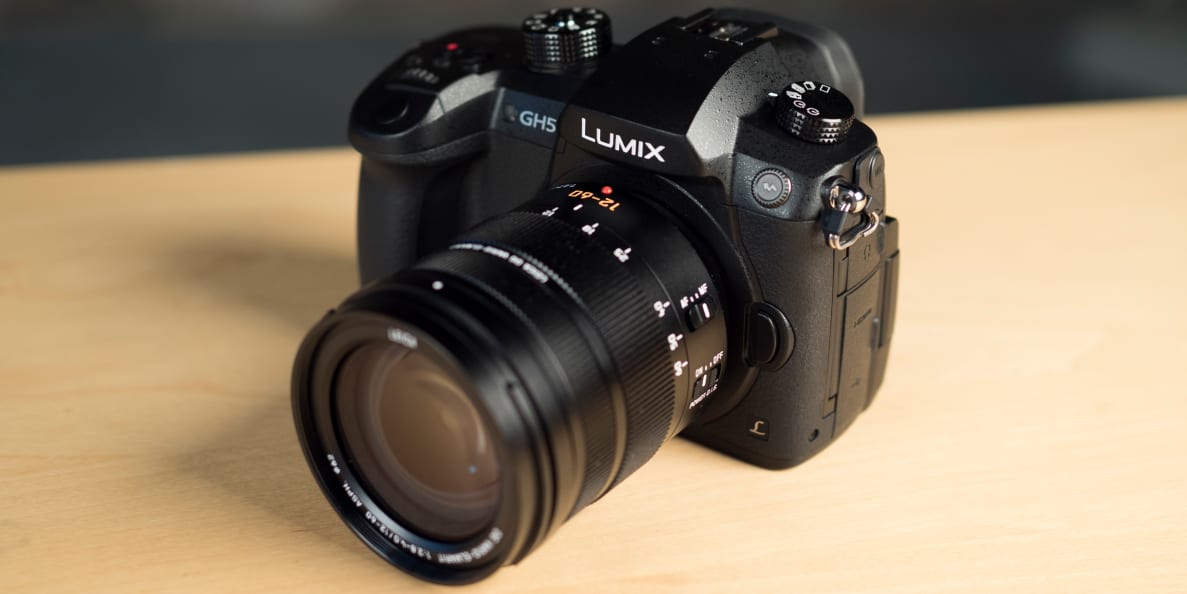Similarly, the new Panasonic Lumix GH5 (MSRP $1,999 body-only) is looking to push the envelope even further, unlocking a performance boost without having to buy an entirely new setup.
While the GH5 isn't quite the groundbreaking camera that the GH4 was, it packs Panasonic's latest still and video technology. That means you get a sharp, 20-megapixel sensor, in-body image stabilization (a first for a flagship Lumix), and exclusives like DFD Autofocus. Even though it's the same price as the blisteringly fast Olympus OM-D E-M1 Mark II, it's got an ace up its sleeve in the form of 6K Photo, the next generation of Panasonic's video-based burst. And if you think that 6K Photo is impressive, just wait until you hear about what GH5 can do when shooting 4K video...
What We Like
New design that gives the GH5 a functional upgrade While the GH cameras have never been the hottest around, the GH5 introduces a new look that's super useful, too. Controls are bigger and a meatier grip makes this GH5 a little bit nicer to hold. Additions like the enlarged rear vertical dial, an awesome AF selection joystick, and slightly relocated top controls make for significant handling improvements overall.
Taking a look at the ports side of the camera, you'll find something that video folks have been asking, nay, pleading for: a full-sized HDMI port. No longer will power users have to use microHDMI cables when hooking up external monitors and recorders. Additionally, Panasonic's migrated to USB 3.0 with a USB-C connector, positioning the GH5 well for the future. On the opposite side of the camera, there are twin SD card slots, with UHS-II speed compatibility. Of course, Panasonic's software lets you customize whether to do an overflow setup, or to break up
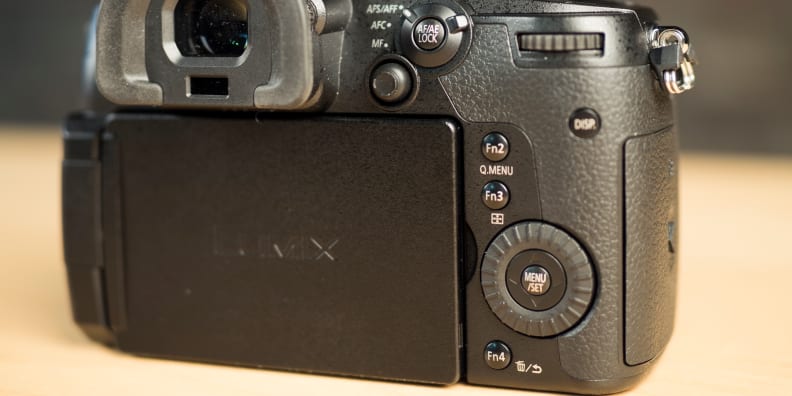
Features that put Olympus on notice Panasonic's latest flagship shows that it's looking to close the feature gap between its cameras and Olympus'. Both Micro Four Thirds platform mates have usually staked out their own territory, Olympus with stills on lock and Panasonic grabbing way better video. With the GH5, Panasonic's taken a critical page from Olympus's playbook, including in-body image stabilization that works on 5 axes to smooth out video and stills.
On paper, the GH5 is down by around 1.5 stops compared to Olympus's Sync IS with 6.5 stops of protection, but it's up in the air as to whether or not that's going to make a difference in the real world. But, given the choice between IBIS and relying just on OIS in Panasonic's lenses, I'd definitely prefer what Panasonic's implemented in the GH5.
Inside the camera's new stabilization system is a new sensor that'll give the Olympus OM-D E-M1 Mark II a run for its money in most areas. Clocking in at 20 megapixels, this Lumix's sensor also goes without an AA filter for maximum sharpness. Where the 20 MP units in the competing Oly and Panasonic flagships differ is when it comes to on-sensor PDAF. Panasonic seems more than happy with its software-based AF technologies like DFD, and so the sensor in the GH5 doesn't have any on-sensor phase detection points. We'll have to see how that impacts AF tracking performance, but until we get our hands on a final copy of the GH5 we won't know for certain.
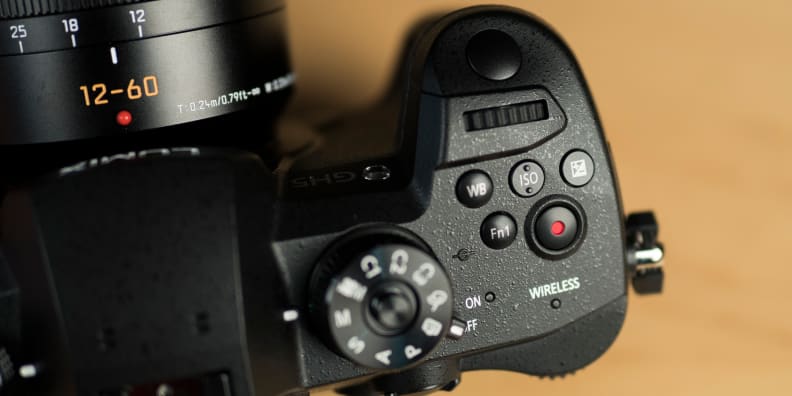
If you thought that Panasonic's 4K Photo was a pretty cool feature, 6K photo gives you even higher-quality stills at the same amazing 30 frames per second rate. The new flagship OM-D might be able to dump 60 RAW images per second to its internal buffer with AF and AE locked, but Panasonic is offering its 6K (18 MP) pictures with full continuous focus and exposure tracking. In addition, 4K Photo gets a boost to 60 fps, if you're okay with having those 8-megapixel shots. We'll have to try this feature in the real world to know how good it is, but again we're excited to see what Panasonic's pulled off.
Superhero video powers: in-camera Cinema 4K/60P...and 4:2:2 10-bit for 4K/30!
If the GH4 wowed in 2014 with its promise of usable MP4 4K/30p footage at 4:2:0 8-bit in-camera, then the GH5 ups the ante in the way you'd expect. The GH5 is able to capture what the GH4 could only manage with an external recorder like an Atomos: 4:2:2 10-bit 4K at 10 bits in-camera to an SD card. Simple. Of course, that's all fine but how about 4K/60p? In-camera, but with a penalty of only 4:2:0 8-bit quality.
Now, not all the GH5's touted video shooting resolutions are going to be available right off the bat. For instance, the spec sheet we've seen from Panasonic shows they have two big firmware updates in the works for the GH5: one for the second half of 2017 and an earlier update in April. If you wanted to shoot 1080/60p at 200Mbps with 4:2:2 10-bit and All-I, you're going to have to wait. That said, the ability to capture high bit rate video, even 4K/30p at up to 400Mbps All-I, is nothing short of astounding. Variable frame rate options go all the way to 180 fps in some FHD resolutions.
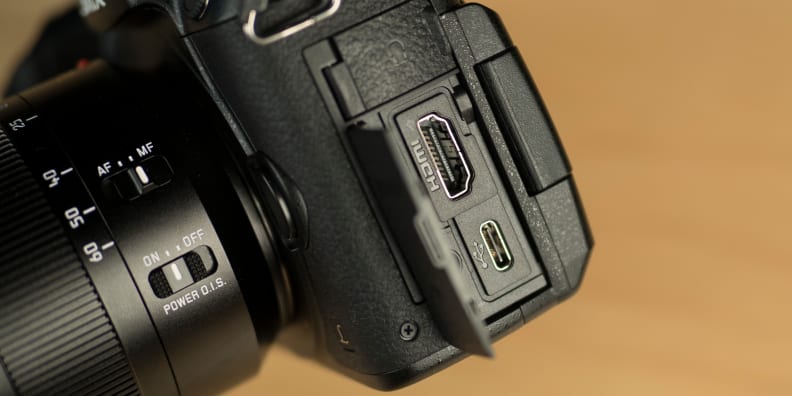
Throw out your microHDMI cables! GH5 has a legit, full-sized HDMI plug.
A lot of the new video abilities stem from a faster (1.7x, according to Panasonic) sensor readout which should reduce rolling shutter substantially. The faster sensor also lets the GH5 get away with shooting 4K without a sensor crop, so Micro Four Thirds lenses retain their effective focal length no matter if you're rolling 1080p or 4K.
Even more advanced video features include an in-camera waveform monitor and vector scope, which was a big surprise. While it's not uncommon for pros to use this feature in an external monitor setup, having it in-camera, assuming it's a decent implementation, means one less bit of equipment to lug to your shoot. Color profiles on offer include both a CinelikeD and CinelikeV. Like the GH4, GH5 also has an anamorphic mode with a wide variety of shooting resolutions, bit rates, and frame rates to choose from.
What We Don't Like
Full-frame and APS-C competition does great work for less It's no surprise that Panasonic is leaning into video even further with the latest GH camera. It's been the company's strong suit for some time, and the love these cameras get is earned by having the skills to pay the bills. They rock for pro video folks, but we're a little uncertain about this camera's still chops.
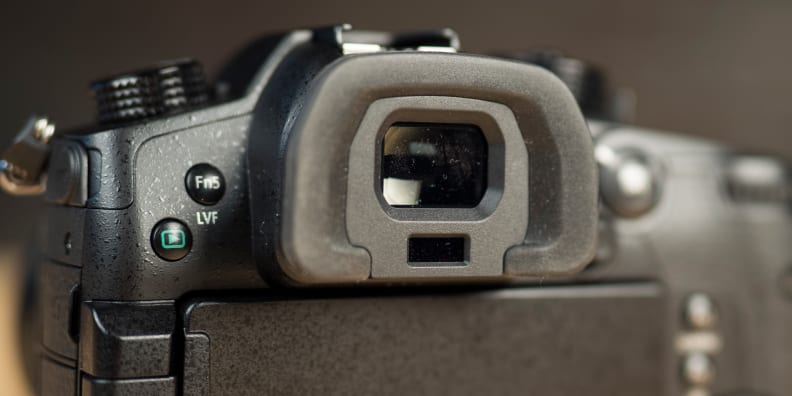
The OLED EVF has a huge, sharp picture thanks to a new 3,680K-dot panel.
Sure, it'll be able to hang with the OM-D E-M1 Mark II just fine, but 2,000 smackers can get you one heckuva camera setup. The GH5, like the E-M1 II, might have overextended out of many enthusiasts' budgets and into territory that Micro Four Thirds has barely scratched before.
$2K pricing says "only pros need apply" and if you're an enthusiast, you're probably going to want the biggest sensor money can buy. For that kind of money, you're easily looking at a full-frame Sony A7, an awesome Fujifilm X-Pro2 perhaps, or maybe even a really great full-frame DSLR like the Nikon D750.
The advanced video capabilities of the Lumix GH5 are barely rivaled at its price, but if you're mostly concerned with stills and video is a secondary feature, there's no doubt that you'll do way better with cameras that are significantly cheaper with a bigger sensor to boot.
Function over form means it's not amazingly designed There's no doubt that this is a workman-like camera. If you were hoping for something cooler-looking, then you're going to want to look elsewhere. For instance, Olympus offers its jewel-like PEN-F for a lot less, and for my money, the Fujifilm X-T2 is far more attractive and fun to use. Since most cameras are really great these days, style is something to consider. If you don't love the way your camera handles or looks when you're shooting with it, then what's the point?
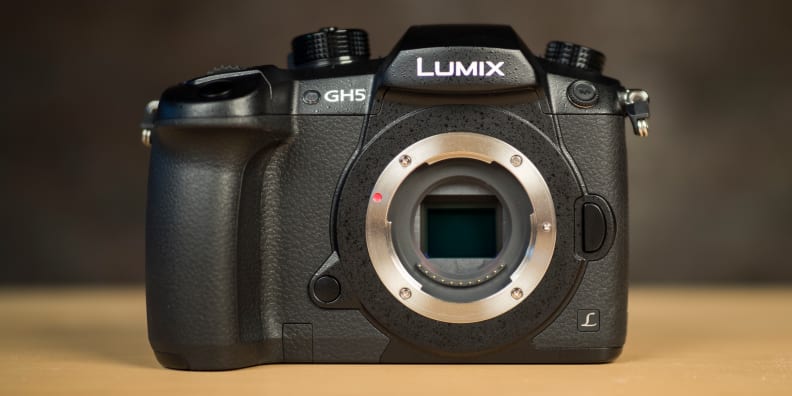
In-body stabilization is a first for a Panasonic flagship camera.
Vlog L will still cost extra money Apparently $2,000 isn't enough to get users the super-flat color profile for grading that the pros are going to want. The GH5 might be able to record in global video formats, and it might have a great waveform monitor feature built-in, but Vlog L? Forget it...just like with the cheaper GH4, you're looking at least a $100 to unlock this capability. So, if you're dissatisfied with the Cinelike profiles that are included with the GH5, you better start busking on the street corner.
Conclusion
This could be the video camera to beat for 2017.
In the past year, Panasonic released some amazing gems in the G85 and GX85, giving users advanced features for not a whole lot of cash. The GH5 is the opposite, pouring raw video performance and features into a camera that's pretty expensive all things considered. While we doubt we'll see another amazing mirrorless camera like this in 2017, Panasonic might be sacrificing well-heeled still photographers to get more videographers to bite.
That said, the combination of features like 5-axis in-body stabilization, in-camera 4K/60p (or 4:2:2 10-bit 30p for that matter), and the high-res, high-speed 6K photo make the GH5 stand out compared to traditional DSLR counterparts. In particular, this camera puts Canon's lukewarm 5D Mark IV to shame, and not simply because the Canon shoots ungainly 4K in MJPEG format, either.
For $1,500 more than this new Lumix, Canon fails to deliver the raw performance that pros will want in a couple years. Granted, you'll need to wait for Panasonic to deliver on its firmware promises to get everything on the current spec sheet, but you'll still get a more potent, cheaper package with the Lumix.
The GH5 retains all the advantages of previous GH cameras but it gets a huge performance boost. It isn't the game-changer that the GH4 was two years ago, but few cameras can do what that one pulled off, and we'll have to wait for another big leap for that to happen. Like the GH4, though, we expect the GH5 to get more useful over the next few years, when things like 4K/60p really start to pay off for videographers.
As it stands, regardless of price, the GH5 is an impressive effort and we can't wait to get our hands on a copy to run through our labs.
Meet the tester
Brendan is originally from California. Prior to writing for Reviewed.com, he graduated from UC Santa Cruz and did IT support and wrote for a technology blog in the mythical Silicon Valley. Brendan enjoys history, Marx Brothers films, Vietnamese food, cars, and laughing loudly.
Checking our work.
Our team is here to help you buy the best stuff and love what you own. Our writers, editors, and experts obsess over the products we cover to make sure you're confident and satisfied. Have a different opinion about something we recommend? Email us and we'll compare notes.
Shoot us an email